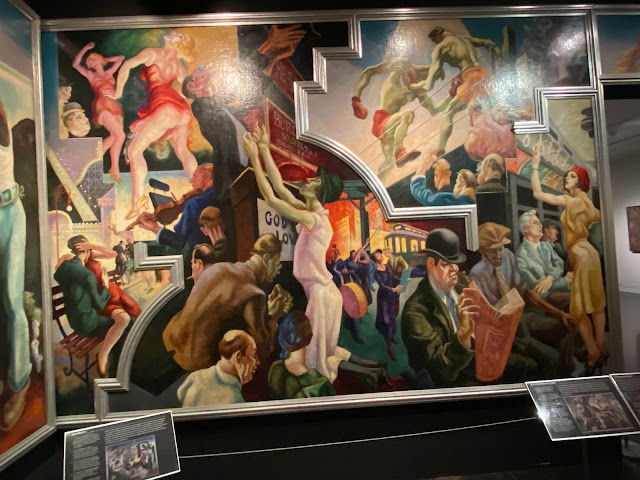Day 340 - Thomas Hart Benton room
May 9, 2023
Gallery 909 turns out to be spread over two rooms. The second, its four walls set up to display a group of paintings by Thomas Hart Benton entitled "America Now," is worth an entry in itself. The paintings, executed in 1930-31, were commissioned for the board room of the New School for Social Research. When that institution found their upkeep too expensive, they were acquired by what was then the Equitable Life Insurance Company, and when Equitable moved its headquarters out of New York City, the Met obtained the collection.
The ten panels are crammed with detail and repay close attention. The imagery points to Benton's complex view of a country in transition, full of energy but also with elements of hardship and injustice. (I imagine that Benton had the social consciences of the New School board members, as well as his own, firmly in mind.) The largest painting, entitled "Elements of Power,"depicts a locomotive whose diagonal form suggests that it is hurtling forward into the future; other images in the painting include a combustion engine, a plane, and a dam generating hydroelectric power. Interestingly, this is the only painting in which people are absent. Several paintings represent different parts of the country: the South, the Middle West, the West, and the city. Cotton remains king in the South and is largely cultivated by Black people, including both a tall, well-muscled figure in the foreground who empties a cotton sack and two small figures behind him who, if you look carefully, are seen to be members of a chain gang. The Midwest remains the agricultural heartland, symbolized by a wheat field and by grain elevators, although industrialization is under way. The West already has changed. Oil wells and airplanes dominate the panel; in the upper righthand corner, a lone cowboy, symbol of a disappearing past, rides the range. Other paintings deal with construction and with coal and steel production and show gnarly, strong-bodied men hard at work.
A group enters the gallery, and the docent remarks that Benton loved New York City. Maybe so, but the two panels depicting scenes of city life seem to me to present a cynical contrast with the images shown in the other panels. Cities, it seems, are the place not for heroic hard work but for having fun, And that fun seems shot through with the potential for corruption: one panel shows skimpily-clad women in dance halls, suited men cheering boxers who are pounding each other in a ring, and a man surreptitiously grabbing the dress of a standing subway rider. Progress has come, but at what cost?
Since I only recently got back from Mexico, it's particularly interesting to think of these panels in association with the socially conscious murals painted by Diego Rivera at roughly the same time. (I later learn that Benton and Rivera frequented the same cafe in Paris and were almost certainly aware of each other's work.) Rivera's output is more explicitly political, and avowedly leftist. Benton recognizes and occasionally depicts exploitation, but it's not a central concern.






Comments
Post a Comment